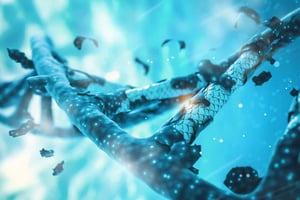So-called junk DNA could play an important role in the onset of autism. This is what is being claimed by neurologists from the Flatiron Institute’s Center for Computational Biology of New York, who published the results of their study in the scientific journal Nature Genetics. Junk DNA is the part of our genetic code – a good 98% of the total – that does not code any protein (and this is why it is also called non-coding DNA). For a long time, it was thought that it served no purpose, but with the passing of time it has become increasingly clearer that, although it does not directly produce protein, this part of our genetic code has many other functions, especially that of regulating the “expression” of coding DNA.
Now this has been confirmed by the study by the US researchers, and also offers a new interpretation of autism. “This is the first clear demonstration”, said Olga Troyanskaya, deputy director for genomics at the Center for Computational Biology, “that non-hereditary and non-coding mutations can cause an illness or a complex human disorder”. In the case of autism, these mutations, in fact, support other, already known mutations, which are present in the coding part of DNA and appear in approximately 30% of people with autism.
But how did the US researchers show that junk DNA plays a possible, important role in autism (or at least, that it can increase the risk of autism emerging)? The neurologists and geneticists used very powerful artificial intelligence and deep-learning systems that identify possible interaction between junk DNA traits and coding genes (i.e. in simple terms, those capable of predicting the possible “wrong” regulation of the coding genes by junk DNA). Using these tools, the researchers examined the genetic code of 1790 people with autism and that of their siblings and parents (who do not have the disease). And they discovered that there was an unusually high number of potentially negative mutations inside the junk DNA of the people with autism. These mutations, on the other hand, appeared to be absent in their healthy relatives and were therefore most probably specific to the illness, random and spontaneous.
With regard to their function, it is probable – say researchers – that these mutations have a negative influence on the maturing of nerve cells during foetal development and in the first years of life: and this would explain the effects of autism on cognitive and behavioral capacity. The new interpretation of the possible causes (or contributing factors) of autism could lead to new therapies in the future to cure this illness, which is still extremely difficult to treat. This is, at least, what the researchers hope.

